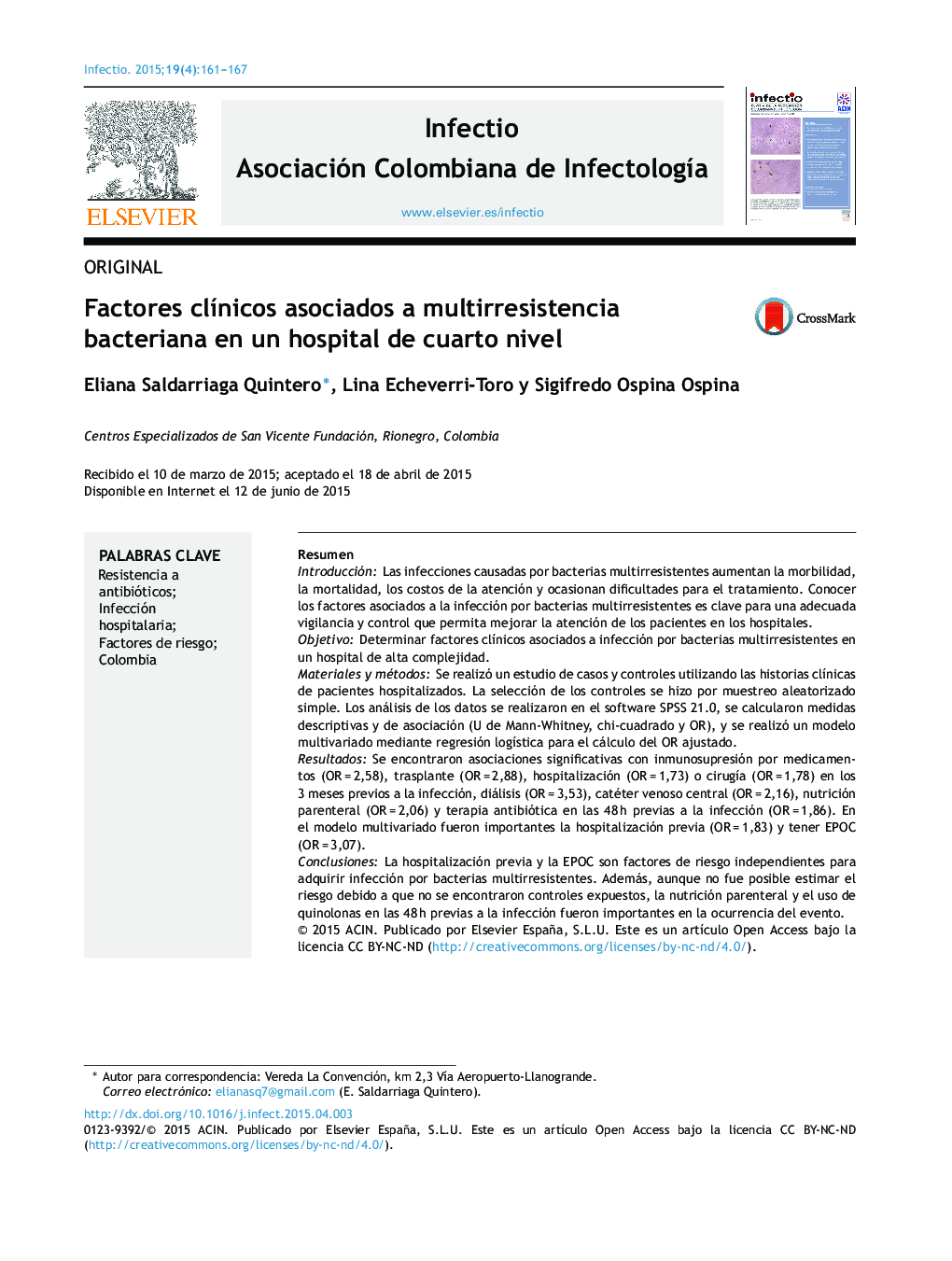| Article ID | Journal | Published Year | Pages | File Type |
|---|---|---|---|---|
| 3403682 | Infectio | 2015 | 7 Pages |
ResumenIntroducciónLas infecciones causadas por bacterias multirresistentes aumentan la morbilidad, la mortalidad, los costos de la atención y ocasionan dificultades para el tratamiento. Conocer los factores asociados a la infección por bacterias multirresistentes es clave para una adecuada vigilancia y control que permita mejorar la atención de los pacientes en los hospitales.ObjetivoDeterminar factores clínicos asociados a infección por bacterias multirresistentes en un hospital de alta complejidad.Materiales y métodosSe realizó un estudio de casos y controles utilizando las historias clínicas de pacientes hospitalizados. La selección de los controles se hizo por muestreo aleatorizado simple. Los análisis de los datos se realizaron en el software SPSS 21.0, se calcularon medidas descriptivas y de asociación (U de Mann-Whitney, chi-cuadrado y OR), y se realizó un modelo multivariado mediante regresión logística para el cálculo del OR ajustado.ResultadosSe encontraron asociaciones significativas con inmunosupresión por medicamentos (OR = 2,58), trasplante (OR = 2,88), hospitalización (OR = 1,73) o cirugía (OR = 1,78) en los 3 meses previos a la infección, diálisis (OR = 3,53), catéter venoso central (OR = 2,16), nutrición parenteral (OR = 2,06) y terapia antibiótica en las 48 h previas a la infección (OR = 1,86). En el modelo multivariado fueron importantes la hospitalización previa (OR = 1,83) y tener EPOC (OR = 3,07).ConclusionesLa hospitalización previa y la EPOC son factores de riesgo independientes para adquirir infección por bacterias multirresistentes. Además, aunque no fue posible estimar el riesgo debido a que no se encontraron controles expuestos, la nutrición parenteral y el uso de quinolonas en las 48 h previas a la infección fueron importantes en la ocurrencia del evento.
IntroductionInfections caused by multidrug-resistant bacteria increase morbidity, mortality, care costs and cause difficulties with treatment. Understanding the factors associated with infection by multidrug resistant bacteria is key to proper monitoring and control and to enabling improved patients care in hospitals.ObjectiveTo determine the clinical factors associated with infection by multidrug-resistant bacteria in a quaternary care hospital.Materials and methodsA retrospective case-control study was performed using the medical records of hospitalized patients from October 2011 to July 2014. The selection of controls was carried out by simple random sampling. The data analysis was performed using SPSS 21.0 software, descriptive and association measures (Mann-Whitney, chi-squared and OR) were calculated, and a multivariate model was performed using logistic regression to calculate the adjusted OR.ResultsWe found significant associations with immunosuppressive drugs (OR = 2.58), transplantation (OR = 2,88), hospitalization (OR = 1.73) and surgery (OR = 1.78) in the 3 months prior to infection, dialysis (OR = 3.53), central venous catheters (OR = 2.16), parenteral nutrition (OR = 2.06) and antibiotic therapy within 48 h prior to infection (OR = 1.86). In the multivariate model previous hospitalization was important (OR = 1.83) and COPD (OR = 3.07).ConclusionsPrevious hospitalization and COPD were independent risk factors for acquiring infections by multidrug resistant bacteria. In addition, although it was not possible to estimate risk because we did not find exposed controls, parenteral nutrition and the use of quinolones in the 48 h prior to infection were important factors in the occurrence of infection.
